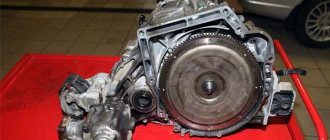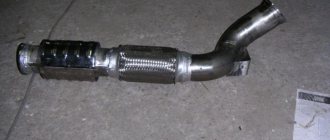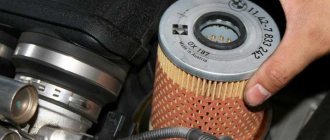The Tiptronic car service center will replace or repair automatic transmission solenoids in Moscow. For a car with an automatic transmission, malfunctions with this solenoid valve are quite typical. They are responsible for opening/closing the oil channel and ensuring normal operation of the valve body. When they fail, errors and problems appear in the functioning of the automatic transmission, which are recommended to be eliminated in a timely manner.
Our service has extensive experience, including repairing automatic transmission solenoids and replacing solenoids. The price, quality and repair time for automatic transmission solenoids will definitely please you. Repairs are guaranteed.
| Title of works | Price |
| On-site automatic transmission diagnostics in the Moscow region | 2000 rub. (For repairs - free of charge) |
| Automatic transmission diagnostics | For free |
| Removal and installation of automatic transmission | from 5000 rub. up to 12,000 rub. (depending on brand and type) |
| Disassembly and reassembly of automatic transmission and troubleshooting of automatic transmission | from 6000 to 10000 rub. (depending on brand and type) |
| Changing the automatic transmission oil | from 600 rub. up to 1500 rub. (depending on brand and type) |
| Flushing the automatic transmission cooling system | from 600 rub. up to 1500 rub. (depending on brand and type) |
| Pressure testing of the automatic transmission cooling system | 700 rub. |
| Checking the pressure of the working fluid in the automatic transmission | from 600 rub. up to 1200 rub. |
| Disassembly, assembly and maintenance of the automatic transmission valve body | from 2500 rub. up to 6000 rub. (depending on brand and type) |
| Automatic transmission torque converter repair | from 3500 rub. up to 7000 rub. (depending on brand and type) |
| Towing a car with a faulty automatic transmission | For free |
How to repair automatic transmission solenoids
This is an electrovalve regulator, which is controlled by the automatic transmission electronic unit and is responsible for opening/closing the oil channel. It controls the oil pressure in the box when changing gears and removes the torque converter lock.
Structurally, this part is quite simple: it is a metal rod wrapped in a spiral. It is located directly in the valve body, where it actually combines two transmission systems - hydraulic and electric. Each “machine” has at least 4 such electromagnetic valves, and as practice shows, they are often the ones that need repair or replacement.
Types of solenoids
According to the principle of operation of automatic transmission solenoids described above, the simplest devices operate, having two states - on and off. They are still used today, only having received a slightly more improved design for more reliable operation. But more complex valves were created in parallel, for example, if two solenoids operate side by side in antiphase, then why not use one switching one? This was done, and two-channel valves appeared. Or three-channel, if you count the input highway. Such a solenoid can transfer fluid pressure from one output port to another, for example, to remove flow from a transmission clutch piston and dump fluid into the crankcase.
The next most complex device was the adjustable valve. It does not have two “open-closed” positions, but is capable of smoothly changing the cross-section of the passage channel. To do this, a voltage varying in magnitude is supplied to it; usually for these purposes, key regulation using the pulse-width method is used, as it provides the highest efficiency and minimal heating of the electronic control key. This design allows for smoother gear changes, making this process invisible to the driver.
Solenoid location
Replacement or repair of automatic transmission solenoids
The automatic transmission is a rather complex unit. The failure of some of its elements can lead to the failure of others. Timely diagnosis and verification of any suspicious symptoms at work allows you to prevent more significant repair costs. So, if the solenoid valve is not repaired in time, which is a fairly simple procedure, then the valve plate assembly may need to be replaced. This is already very expensive equipment, and it will take more time to fix such a complex problem.
Automatic transmission solenoids | general information
Design and operating principle
The design of the solenoids consists of a special magnetic rod, inside of which there is a copper winding. A direct current is supplied through the winding, which pushes the magnetic rod in the direction of oil movement. When the current voltage changes, the magnetic rod moves in the opposite direction. Despite its apparent complexity, this design is simple and easy to operate. In modern automatic transmissions, solenoids move not only under the influence of changes in the direction of current, but also due to a special return spring. This ensures increased reliability of the device and the ability of the solenoid to function correctly in case of problems with the power supply.
The solenoids are located in special channels of the valve body through which the oil fluid moves. When the channel is open, the oil circulates freely through the channel and is directed to the moving parts of the box or to the oil receiver for subsequent cooling.
- Operating principle of the hydraulic unit
The operation of the solenoids is controlled using a computer, which is connected to the electric valves using a special cable. It should be noted that the loops through which control signals are transmitted to the electric valves are the weak point of the design and quite often fail. That is why, if there are problems with the operation of the solenoids, first of all, repair shops check the functionality of the loop.
Valve blocks in most models of modern gearboxes are located at the bottom of the box. Only in some transmissions the valve body is located on the left or right side. The lower location of the electric valves significantly simplifies repair work. Replacement of solenoids in automatic transmissions can be carried out at specialized service centers. Please note that this work is carried out without removing the automatic transmission from the car.
Service life: how long do they last and when is it time to change automatic transmission solenoids?
The service life of solenoids in the valve body of an automatic transmission directly depends on the quality of the transmission fluid used and the intensity of use of the vehicle. Failure of the solenoids occurs either as a result of overheating of the automatic transmission, which leads to damage to the connection cable between the sensor and the ECU, or as a result of clogging of the ball mechanism with wear products of the box as a result of severe contamination of the ATF oil.
If the regulations are followed, replacing the transmission fluid in the box at least once every 60,000 km and flushing the automatic transmission valve body is required every second maintenance. If there is no complete flushing of the valve body after 100-110,000 km, the service life of the automatic transmission is reduced by half.
Types of solenoids
As it became clear from the previous paragraph of the article, it is difficult to imagine controlling an automatic transmission without solenoids. Depending on the principle on which these mechanisms operate, it is customary to distinguish several generations of installations. Today there are three main types of solenoids:
- The first is a standard electromechanical valve that works on the principle of “completely open the oil supply channel or completely close it.” Accordingly, when such a solenoid is open, transmission fluid flows freely through the valve body channel, and when closed, oil does not flow;
- The second is a solenoid, represented by a solenoid valve. Such mechanisms were at one time very popular in the automotive industry, as they could accurately organize the operation of automatic transmissions. Despite this, the low reliability of electromagnetic solenoids has greatly undermined their popularity, so they are practically not used in large-scale automotive production. The main feature of these devices is that the rod can not only completely open or close the oil supply channel, but also do it partially, gently regulating the supply of transmission fluid;
- The third is a solenoid, represented by an improved solenoid valve. This mechanism has in its design not just a rod that locks/opens the channel, but a finely working hydraulic valve. The operation of such solenoids is based on the fact that oil movement is controlled using a ball valve. In fact, such a device allows you to fine-tune the operation of the automatic transmission, but at the same time it is noticeably more reliable than the second type of solenoids, therefore it was widely used at the time of its appearance. Moreover, the newest solenoids have a filter element in their design, which, when transmission fluid passes through it, filters out excess debris and significantly extends the service life of the box.
Over time, the design of the automatic transmission became more and more complex, so the operating principles of automatic transmission solenoids also became more complicated, which is why they were subjected to intensive modernization. The main improvements concerned the transfer of additional functions to the valve, such as relieving pressure in a specific clutch block of the box or blocking the torque converter clutch.
Types of solenoids in modern boxes
The ideas of automotive engineers made it possible to achieve similar goals. Now, numerous types of solenoids are not only responsible for shifting gears, but also subtly control the operating modes of the automatic transmission. Today, a standard automatic machine has 6 types of solenoids in its design:
- EPC formation solenoid or line pressure valve. This solenoid is the most important in the design of the automatic transmission and is always the first in the valve body. The main function of a linear solenoid is to control the flow of oil into a specific channel. The load on this mechanism is high, so it breaks down most often and is subject to priority inspection;
- TCC formation solenoid or valve that locks the torque converter clutch. This device, as a rule, turns on when the engine is running at high speeds and is partly responsible for increasing the efficiency of the engine. During “weak” driving, this solenoid does not work;
- Shift solenoid or shift valve. It is located behind the linear valve, has a complex structure and performs the most important function of the entire valve body - it changes gears through a precise supply of transmission fluid through the appropriate channels;
- Control solenoid. Perhaps the simplest device in the entire valve body, because it has only one simple function - monitoring the operation of all other solenoids. The operation of the control valve is very similar to how the transistor of any microcircuit works;
- Slip solenoid. Such a valve organizes a smooth transition from one gear to another, that is, switching the operation of the machine to slip mode;
- Cooling solenoid. The same mechanism releases heated automatic transmission oil into the cooling sections, which is necessary for stable operation of the box.
It is important to understand that for each clutch (transmission) pair there is not one solenoid, but several of the ones noted above. Stable and problem-free operation of the automatic transmission is possible only with the normal operation of all valve body valves, so you need to treat them with the proper level of responsibility.
Why are solenoids needed in an automatic transmission?
The solenoid block in the automatic transmission opens and closes the channels in the hydraulic plate for the passage of ATF oil to the gearbox components. This happens as follows:
- When you need to change gear, the ECU electronics send a control pulse to the oil pump and certain Shift-type solenoids.
- The pump creates pressure. The liquid enters the valve body.
- The voltage across the solenoid valve creates a magnetic field in the coil winding. Under the influence of magnetic forces, the rod - the plunger - moves, opening a channel for oil flow. Another solenoid operates in parallel, relieving pressure in the previous gear.
- ATF passes through the hydraulic plate channel to the piston. Under fluid pressure, the piston compresses the friction discs, which brake the gear train in the planetary mechanism.
- The ECU receives a signal that the speed has been successfully switched and removes the current supply.
- The magnetic field in the coil is destroyed, and the plunger, under the action of a spring, returns to its place, closing the channel.
In addition to shifting gears, electric valves are responsible for blocking the automatic transmission torque converter. They are called TCC - Torque Converter Clutch. In modern designs, the lock-up clutch is connected from 2nd gear to reduce power loss and enhance acceleration. In this case, the oil in the torque converter heats up faster and becomes contaminated with friction dust.
Why else are solenoids needed in an automatic transmission:
- control and distribute the total ATF flow through the channels of the hydraulic plate (EPC linear pressure coil);
- create “soft” shifting with “slip”;
- regulate, like a thermostat, oil cooling through the radiator.
Along with the development of the electronic control system of the automatic transmission, the functionality of the solenoid valves has expanded. Initially, the coils worked on the “open-close” principle. Later, new designs appeared with the ability to adjust the flow and switch between 3, 4 or 5 channels.
Repair and replacement of solenoids in TOP automatic transmission Service
TOP automatic transmission service specialists perform complex repairs and replacement of solenoids with a 12-month quality guarantee. For faulty vehicles, we provide a tow truck throughout the city and region, which will deliver you to the nearest service station at any time of the day. We also perform free computer diagnostics subject to subsequent repairs.
You can sign up for diagnostics at TOP Automatic Service or call a tow truck using the phone number on the website or fill out the feedback form and we will call you back.
Typical problems
Very often, solenoids become unusable due to burnout of the electrical winding. Carbon deposits appear on the plunger. It becomes clogged with very fine dust from various consumables and components. In such cases, the spool valve begins to jam either at operating oil temperature or “cold”. This can be easily corrected by washing in special solvents. Craftsmen use ultrasound or alternating current to clean parts. In some cases, the friction lining wears down to the adhesive substance. Then glue is added to the soot along with the dust. This will significantly complicate the repair procedure.
We recommend: Adaptive adjustable suspension: what is the secret to the handling of expensive cars?
A popular cause of failure is also wear and tear on the components of the solenoid itself. It could be:
- manifold;
- bushings;
- valve;
- plunger;
- ball.
Most often, from my own experience, I can say that the plunger itself becomes clogged with products from wear of the clutches. Then switching problems appear. The carbon deposits that appear on the surface abrade the rubbing surfaces of valves and bushings. Bronze bushings wear out very often. There are special kits for replacing bushings yourself. They significantly extend the service life.
Solenoids have their own service life. It is calculated by the number of openings and closings. This figure falls within the range of 300,000 to 400,000 cycles. When exactly this happens does not always depend on mileage, but largely depends on the operation of the electronic control unit when you press the gas pedal. Some gearboxes have an operating mechanism in which some work an order of magnitude more intensely than others. As a result, they will use up the resource earlier.
Another common cause of breakdown is various mechanical damage (cracks) in the housing. Maybe the spring itself is not elastic enough. Or there was a break in the electrical winding.











